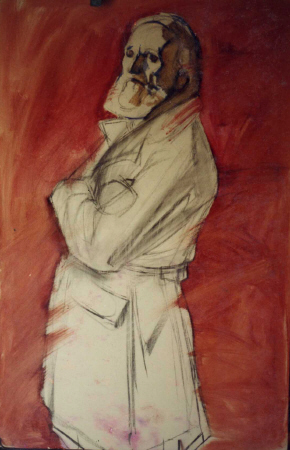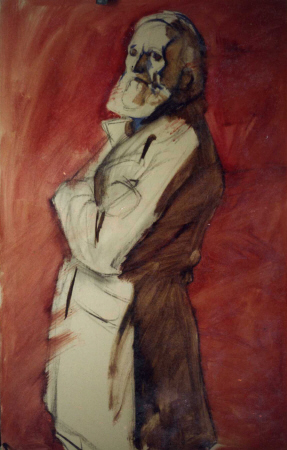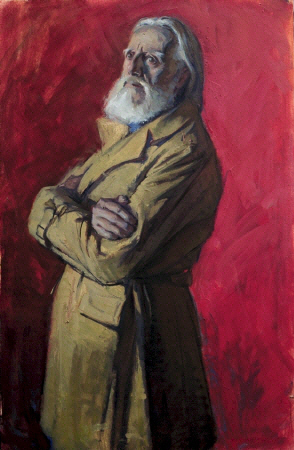
Beginning a Painting
By Dan Gheno
.
.
.
.
.
I take many approaches when starting a painting. In the self-portrait painting on the right, I began with a quick, loose vine charcoal sketch (Stage 1 below).
Once the proportions were loosely established, I reconfirmed the drawing
with paint. I mixed alizarin crimson with a great deal of turp so that it flowed
with the consistency of ink. Then I
used this concoction to “ink” the charcoal lines with a small brush. I
normally use this inky paint to reconfirm the drawing where it feels correct,
and also to change the drawing where I feel it needs adjustment. The
alizarin combines with the charcoal to make a much darker line than the color
would give by itself (Stage 2 Below). Since the inky concoction is mostly turp, it dries rather
quickly, within 20-40 minutes. I
then dusted off the remaining charcoal, so that it doesn’t dirty up the color
later on (Stage 3 Below). I started to lay in the big value masses in a thin, transparent type,
turp-wash, so that I could still see the underlying drawing. I
began the block-in process by broadly
laying in an average value for the darks, avoiding the darkest darks at first (Stage 4
Below).
.
.
I then blocked in the lights as a broad, average, mid-tone mass (Stage 5 at Right).
I usually try to find my strongest color and big, broad value masses first before I go into any details like the highlights in the light masses or the dark accents and reflected lights in the shadow masses. For instance, in “Pride” (Below), I blocked in the red background early on. This general approach allows me to better gauge the more subtle color and value masses (like the model's skin tones) against something more immediately obvious. Once the big masses are blocked in, I frequently place in a spot of my lightest light and darkest dark as extreme reference points for all the other values in between.
.



College of Fine Arts
.
Come back soon for part two of this series.
.
GHENO TEACHES AT: THE
ART STUDENTS LEAGUE OF NEW YORK
AND: THE NATIONAL ACADEMY OF
DESIGN, SCHOOL OF FINE ARTS,
NEW YORK, NY
Last Update: 7/1/2011
All Contents (text and images) © 2011 by Dan Gheno